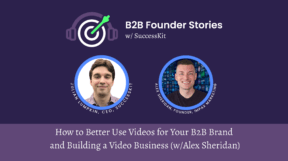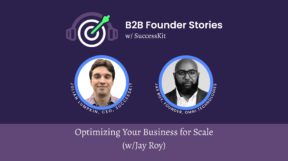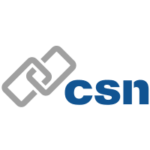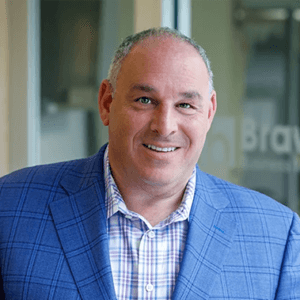Listen to this episode now on Spotify or Apple!
In the ninth episode of our podcast, B2B Founder Stories, Julian speaks with William Lieberman, the founder and current CEO of the strategic financial advisory firm The CEO’s Right Hand, about the important differences between running tech companies and running professional services firms. He identifies the typical growth trajectory of a great professional services firm, notes what both tech and pro serv company founders tend to get wrong, and weighs in on what type of company to start first.
“[Great founders and CEOs] have a very clear understanding of their market. They have a very clear understanding of the value proposition for the product or service that they’re creating and have built, and they are able to marshal the resources, both human resources and capital, to build and execute on that vision. There’s lots of visionary CEOs that are just out there that have these ideas but can’t build the team and can’t focus them on, ‘Here’s what we’re going to do, and here’s how we’re going to do it.'”
William Lieberman, The CEO’s Right Hand
Transcript of Podcast Episode 9: Running Tech Companies vs Pro Serv Firms (w/William Lieberman, CEO of The CEO’s Right Hand)
Julian Lumpkin: Welcome back to B2B Founder Stories with SuccessKit. My guest today is William Lieberman. He is the founder and CEO of The CEO’s Right Hand. William has a broad set of experience as an entrepreneur in both technology and professional services firms, as well as with bootstrapped and funded companies. As longtime listeners will know, and new listeners will hear, I’m very interested in the differences between running these different styles of companies. William was kind enough to indulge my questions and share his opinions and expertise on all of these topics. I hope you enjoy the episode. William, thanks for joining me.
William Lieberman: Absolutely. Great to be here.
Julian Lumpkin: So to begin, tell us a little bit about The CEO’s Right Hand.
William Lieberman: Sure. The CEO’s right hand is a strategic financial advisory firm. So we help companies that are anywhere from early stage growth through middle market. Typically, early stage growth through and lower middle market is where we target, and we help companies grow and scale by applying a financial lens to their strategy and implementation of that strategy across the firm. So we have finance, typically CFOs, as well as the folks below them controllers, accounting manager, bookkeepers, sales, and use tax and income tax. And so basically anything with the dollar sign is where we get involved. But the way I like to say it is we act as your financial business partner to help you grow in scale.
Julian Lumpkin: Nice. And can you give us a general sense of how long you’ve been around, how many employees, kind of the size of the company now?
William Lieberman: Absolutely. So I started the firm seven years ago, seven years ago this month, and I built the company up to… We have a team now of 30 people. And I have a business partner, Eric, and we have about 50 clients or so.
Julian Lumpkin: Like I mentioned before, we’re going to talk about your experience founding this company, but I know you’ve got a broader array of experience as an entrepreneur, and I want to talk a little bit about that and kind of compare some of your experience in the tech world versus what you’re doing now in professional services. So can you give us the quick background of your experience prior to this company in the technology world?
William Lieberman: Sure. So just rolling the tape back, I graduated from business school, went to Wall Street and did that for a few years. And then I actually started, co-founded an investment management consulting firm, and I ran operations in finance for that company. And part of that company, which is a small firm, but part of that company, I launched a business, or I’m sorry, a technology business unit that was supporting that investment management side of things. And after a few years, we spun that out. I spun that out into a separate FinTech company that I founded. And in so doing, I raised capital across a variety of means. So I started with some angel funding, then friends and family, then we did a private placement, and then we did a series A round with a strategic investor, and it was a very long and drawn out process. There’s a whole story there. But from there, I had the capital that I needed to launch and really grow that FinTech company. And we built up to a team of about 55 employees, and plus an offshore team, over many years.
Julian Lumpkin: And how long total from when you started the company versus leaving did you work with that company?
William Lieberman: So I started… Shoot. Geez. So I started… Really, we spun that out in ’98, and I was there maybe about 17 years.
Julian Lumpkin: Nice.
William Lieberman: It was a long… It was definitely a long haul, but it was great. I loved it. I loved growing it and scaling that business, and it was a lot of fun.
Julian Lumpkin: And did you sell the company or sell a portion of the company? How did that end?
William Lieberman: Yeah. So what happened is I sold my stake. So the company still exists, and up until very recently was a client. So it was a client for just about seven years. So even though I sold my stake, I had a great relationship with my co-founder, who’s now running it, the CEO. And so he said, “Hey, can you continue to support me?” And I had people on my team helping them as well.
Julian Lumpkin: Great. So now that we’ve gone over your background, let’s get into some of these really specific differences I wanted to discuss.
William Lieberman: Sure.
Julian Lumpkin: Let’s start with the following. What is the most important difference in running or founding a technology company versus a professional services firm?
William Lieberman: Well, so I mean, the critical piece, of course, is on a tech company, you have to hire the folks and build a team that’s building a product, right? So you have to have the R&D function and the capital to support that R&D function, which is critical in order to get to market quickly with technology that is, for whatever reason, better, faster, cheaper than the competition, or if there’s nothing out there that exists, which, it’s hard to imagine, but maybe it doesn’t exist, but you have to build that team, invest in that R&D, and then invest in all the sales and marketing, et cetera, to bring that product to market. So if you have a product led approach, you got to lead with all that product dev and build out the customer success piece.
William Lieberman: So as you bring that product to market, what’s the customer implementation, what’s the customer support, what’s their SLA hosting, et cetera? So it’s a very different business model than professional services, which is what I do now, where you have a team of people out in the field solving client problems. So now there’s no product. You’re investing in people, so you have to go find the people, et cetera, but you don’t necessarily have to, depending upon the type of professional services that you have, you don’t have to bring on a ton of people ahead of the revenues, versus on the tech side, you’re hiring way ahead of revenues, and you need a lot more capital to do so.
Julian Lumpkin: Would you say overall that starting a technology company is more difficult than starting a professional services firm?
William Lieberman: Oh my gosh. That’s a tough question. So there are for sure things that are more difficult, right? So you have to… You’re taking… In my experience, it’s a much bigger risk because there’s a lot more capital and you don’t know for sure if the market is going to buy that product. So you’re risking not only your capital, but blood, sweat, and equity along the way in the hopes that a year or two or three, when that product really comes to market, then the hopes that there will be people that will be buying that in quantity to really make it significant and have a significant growth path for that company, whereas on the professional services, it’s much easier.
William Lieberman: There’s a lot less risk, because you can say, “Okay, I’m going to try this consulting thing. I’m going to just have one consultant, see if it works. And then if I make some margin, then I could go bring on another, and then I could build much more incrementally because I’m solving problems and getting paid for it all along the way.” So it’s a very different business model. So the risk is a lot lower on the professional services side.
Julian Lumpkin: I don’t know the numbers off the top of my head, but the fact that technology companies fail at a really high rate is pretty well established. In your experience, is it similar in professional services firm, or do you think professional services firms have a higher rate of maybe not huge success, but survival?
William Lieberman: I do think that they have a higher rate of survival, but they have a much lower growth path, right? So you’re just growing along because you can only bill, depending upon the type of pricing model that you have. But typically if you’re on an hourly model, or even a retainer model, you can only get as much as you have people out in the field doing, right? So it’s not like a product where it could be a much higher growth path in terms of revenues, and of course value. So it’s a risk reward. So on the technology side, it’s a higher risk, higher reward. Then in professional services, which is again a lower but more steady growth path.
Julian Lumpkin: Yeah. And we’ve all seen the kind of models for how a technology company is supposed to scale with the famous hockey stick. Obviously, professional service is a little bit different. What sort of growth trends, whether you want to give numbers or just kind of an explanation, in your own words, what does a typical growth of a great professional services firm look like?
William Lieberman: Look, if you can grow your revenues… Forget the first few years, but if you can grow your revenues, once you’re past the initial formation stage, if you can get your revenues to 25, 30% a year, that’s strong growth.
Julian Lumpkin: Twenty-five to thirty percent in professional services. And that’s once you’ve hit what? Say a million in revenue, when would you say [inaudible 00:09:35]
William Lieberman: Yeah. Once you’ve hit… Yeah. So once you hit at least a million, probably closer to two, yeah, one to two million, if you can then from there grow 25, 30%, yeah, double every three years, that’s good growth.
Julian Lumpkin: Interesting. So you, I’m assuming, work with both tech companies and professional services companies now. Looking first at the professional services side, what is something that founders or executives at those firms often get wrong?
William Lieberman: What do they get wrong? That’s an interesting question. So I think, some of the challenges that they’re face… I don’t know get wrong, but some of the challenges that professional services founders, CEOs face today, I mean very common across all companies, is getting the talent that they need in order to continue that growth. And I think people are constrained by talent, especially these days, across all different companies, but on the professional services side, as importantly as anybody. Your assets are your people. And to get the quality people that you can put in front of a client to generate the revenues that you need to generate is really difficult these days. And you have to pay up for it, and it’s expensive, and figuring out the culture to keep those people engaged is really hard, especially in a remote, everybody working from home situation. How do you get across the passion on a Zoom call? How do you get every… You can’t get everybody in front of a whiteboard easily. So those are the types of challenges, on a professional services side, that I think CEOs are facing, even more today than ever.
Julian Lumpkin: My next question, actually, I’m going to phrase it as a statement and let you react. So you may know that I started my company originally as a technology attempt and it morphed into a professional services firm. And one thing that I’ve become interested and heard, didn’t invent this concept, but have heard it quite a bit and starting to believe it, that a lot of founders come from tech background, as I did before this, and their immediate instinct, when they want to be an entrepreneur, is to start a technology company. My belief now is that founders should start kind of in the reverse order that you went, start a professional services firm, learn those motions, learn to build a business a little more slowly, and then, if they so choose, start a technology company. Agree or disagree?
William Lieberman: So, I agree for a couple reasons. So one, to your point, if you start a little bit more slowly, you can get the mechanics of building a business, meaning how do I build a team? How do I build a culture? How do I manage a management team? How do I recruit? What are the proper KPIs for this business? What’s the right management reporting, financial reporting? So, getting that discipline. How do I conserve cash? So getting that discipline in place is critical to being successful. As you mentioned earlier, look at how many companies fail, a lot more on the technology side for sure, but look at how many companies fail in the first three years, or two years even, because they don’t have that discipline. So yes, if you start a professional services firm, it’s easier because there’s less capital at risk to get your legs beneath you. And that’s number one.
William Lieberman: Number two, there are oftentimes where a professional services firm, because they’re interacting with so many different clients and customers, and they’re out and building that intellectual property and know how to serve them in whatever field that they’re serving in, they can build a knowledge base that sometimes, not always, but sometimes can turn into a product. So they can productize their service and become very profitable and start really growing with much less risk, because now they’re taking the IP that they’ve built over 2, 3, 4, 5 years and productizing it for the marketplace. And that’s a really interesting path. I have a client that’s doing that now. And so it’s a lot of [inaudible 00:14:11]. I’ve seen professional services firms do that in the past very successfully.
Julian Lumpkin: Yeah, there’s also an element of, at least what I found, as kind of a benefit of running professional services firm versus technology is that it’s so much easier to try things. Whereas technology, you have a new idea and you’ve got to do all this. I mean, of course there’s ways to test things and do research, but you’re ultimately speculating and you’re trying to make tests. You have to build technology, in most cases, to test a product at a technology company. Where once we kind of dropped the idea of technology and service services, it was like, I had a new idea for something we wanted to try or offer, and we were working on it with a client the next day.
William Lieberman: Right.
Julian Lumpkin: And to me, I think that’s one of the most undervalued aspects of running a professional services firm. Sure if you’ve got 20 million in the bank and a team of engineers, you can move quickly. But if you’re an entrepreneur and in the tech space, whether you’re coding yourself or have one developer, I think what a lot of people don’t understand is how difficult it is to move in that space and figure out what the market needs and how you can serve it. Whereas with professional services, it’s literally just, client wants this, let’s do it.
William Lieberman: A hundred percent, a hundred percent. I mean, you could… Yeah, in tech land, yes, you can wire frame and you can do things that are kind of quickly demonstrate and prototype, but it takes weeks just to do that, and then bringing it to market takes months. So you’re absolutely right. And I’ve done that myself. I’ve created a new service line and wrote… I wrote up the content, had it up on my website within a couple days, had a sales slick, and was out selling within a week. So yeah, you’re absolutely right.
Julian Lumpkin: Nice. So I want to talk a little bit about funding and some of those options. Are a lot of the clients that you work with pursuing or getting venture capital? Are you working with a lot of clients that are going that route?
William Lieberman: So yes, we have and are working with a variety of clients looking for venture capital, for sure, especially when you’re in the sort of series A range, seed capital, less so, right? It’s typically a little bit more friends and family type money. But once they build it up to the point where they need 5 million, 10 million, sometimes even more, then that’s definitely venture capital type funding, absolutely.
Julian Lumpkin: Got it. And we’re recording this in June of 2022, so the market has obviously taking a huge hit. Everyone’s talking about how venture capital is drawing up and kind of companies are forced to focus on profitability. Without getting into kind of two specifics, what type of pressure are companies that you work with that have taken on that venture capital, what type of pressure are they now feeling with the market possibly drying up? Is it true that companies are now kind of pressured to be more cautious and aim for profitability?
William Lieberman: Yes, for sure. I mean, we’ve heard… I had one client who recently closed a 6 million round from a fund and is looking to… They’re looking to an add-on of maybe another 2 million, but they’re seeing and heard from their investor prospective investors that those investors, those VCs are now looking at companies that can survive for 24 months. So you have to have enough capital on hand to survive for 24 months before the next round of funding, as opposed to, it used to be 12 months, was the typical timeframe. So yes, the VCs are definitely telling their portfolio companies and their prospective portfolio companies, “You have to have enough capital on hand,” meaning you have to either tighten up on the expenses or somehow accelerate on the revenue side so that you can last longer now.
Julian Lumpkin: And what’s that like for a CEO that kind of… Is this sort of unexpected? What’s that like for a CEO that is going down the venture path? They’ve hit their numbers they need to raise a particular round, and now the market’s changed and they’ve got to adapt their company to meet that market. What’s that like for a CEO in that position?
William Lieberman: Well, it is never easy, right? It’s never easy. And CEOs have a lot of sleepless nights no matter what, but yes, in times of turmoil and unknowns like this, it makes CEOs have to really focus in on execution, right? So it’s all a matter of blocking and tackling. And look, they always say revenues cure all ails, right? So ensuring that you are growing the business and generating the revenues to fill the coffers, to cover your operating expenses even more quickly than you could do before. And look, if you have to put off some R&D for down the road, what do you need to do today to deliver today to something that customers will pay for today, right? So it’s a laser focus. I had somebody… When I had my tech company, I had somebody on my board who used to say cash is somewhat like crack cocaine. And it won’t always be there and people get hooked on it.
William Lieberman: And so the discipline is how to conserve cash as much as humanly possible so that you can last as long as possible and you don’t have to go get more money. Because if you have to go get more money, it’s going to be really expensive, or you might not be able to get it. So it’s even more discipline now. So CEOs have to be way more cautious of spending cash and conserving cash as much as humanly possible. And it’s a hard discipline, especially, if you wind the tape back six months ago, cash was flowing. And in certain industry verticals, cyber security, right? There was tons and tons of cash [inaudible 00:20:15]. Oh, I’m getting a hundred times ARR as my valuation. Well, those days are different six months since. And so it’s hard, and it’s a reckoning that CEOs really have to understand and be cautious of.
Julian Lumpkin: Well, you could probably tell I’ve got some skepticism about the VC world that I came from, but appreciate you kind of sharing the perspective as someone who’s still working with a lot of these companies. I want to get a sense of how skeptical you are or not, so I’ll do this kind of as a theoretical. You’re advising a young entrepreneur. Not in a business sense. Let’s say it’s your son, or nephew or something. And they’ve got a little traction and an idea, and they tell you know, “We’re surviving. We’re not growing fast, but we’re going to survive and we’re going to keep growing on our own. And I can get a little bank facility for a hundred thousand dollars, and I can take a few years to try to grind this out and turn it into a small profitable company, or medium size profitable company, and then potentially grow.”
Julian Lumpkin: The same person also in that situation has a offer, not from an elite VC firm, but just kind of a standard VC type deal. Of course the devils in the details, but just theoretically, how cautious would you tell that entrepreneur to be about taking the few million dollars versus going a little more slowly and doing it themselves?
William Lieberman: Well, I think the conversation has to be around how much capital do you have to have in order to really be successful? So there are tech companies where if they don’t build the feature set and go to market quickly, they’ll be out of business. And so it kind of depends on the business that the person’s running. And if it’s a business that can survive just growing slowly, and they have barriers to entry, they have IP, or they have some way to protect themselves against entrance to their space, then that’s fine. That’s what I would tell them to do. But if it’s such that, “Hey, if we don’t do this, this, this, and this feature set, we’re going to be out of business,” then of course you have to take the money.
Julian Lumpkin: Yeah. I think in those kind of winner-take-all-type of environments, venture capital’s always going to make sense. But it sounds like if you don’t see that scenario, if you see a path for a company to bootstrap now and grow on their own, you’re generally… You’re advising them towards that.
William Lieberman: Do that, right?
Julian Lumpkin: And if that entrepreneur said to you, “Why? I’ve got… Someone’s offering me 3 million. Why should I turn it down?” what would you tell them?
William Lieberman: So look, when you “get in bed” with a VC or any institutional investor, they’re going to be keenly focused on how do they get liquid. So when are they going to get their money and a good return on their money? And they’re going to be putting pressure on any entrepreneur to grow, grow, grow, and do it successfully, profitably. They might not like the decisions that you’re going to make. So you now have a partner that you are beholden to, albeit minority partner, so they don’t have total control of the business, but you are beholden to what they want and say, and they have legal rights in terms of the decisions that you make as an entrepreneur. And sometimes that control or giving up that control is really hard for a CEO to come to grips with, and it might be too high, a price to pay. And that’s… People focus on the price.
William Lieberman: While they’re giving me X dollar million valuation, and they’re giving me Y millions of dollars of cash, “I should take it, I should take it.” Yeah, but to your point, Julian, the devil is in the details. What control rights do they have for that money? What preference do they have? On and on and on. And it can be, very often, a really bad deal.
Julian Lumpkin: Interesting. So I want to talk a little bit about kind of founders and CEOs from a more general perspective. You obviously interact with quite a few of them. What are the… When you’re looking at a founder of a company, what are the green flags that you see that tell you, this person is going to make a great founder or CEO?
William Lieberman: I mean, there’s some obvious ones, passion, fire in the belly, look if they have a vision. “So here’s where I’m headed, and here’s how I’m going to get there.” So they have a very clear understanding of their market. They have a very clear understanding of the value proposition for the product or service that they’re creating and have built, and they are able to marshal the resources, both human resources and capital, to build and execute on that vision. So somebody who’s very thoughtful, visionary, passionate, but also can understand how to implement, right? There’s lots of visionary CEOs that are just out there that have these ideas, et cetera, cetera, but can’t build the team and can’t focus them, focus on, “Here’s what we’re going to do, and here’s how we’re going to do it.”
William Lieberman: I always liken it to kind of a war thing, right? “So, here’s all your ammunition, and here are all your guns. And the bad guys are over that hill, that hill, that hill, so fire that way, that way, that way.” Right? So they have to be able to focus their team and convince them, “Here’s where we’re going, and here’s why, and here’s why we’re going to be successful,” as well as giving him the roadmap to that success.
Julian Lumpkin: Are there any kind of red flags or things that you see in an entrepreneur or CEO that would concern you?
William Lieberman: So just about every CEO I’ve seen, not every, a lot of CEOs I’ve seen have what I call entrepreneur’s disease, which is simply, “Hey, I’m going to go do this. Oh, look at that. I could do this too. Oh, I could do this too. Oh, I could do this too.” Right? And that lack of focus is a death note. I’ve seen it time and time again. And so people that cannot focus on doing one thing and doing it really well before they do the next one is very problematic. It’s very problematic for the team behind them, beneath them, supporting them. And it’s just…. You just can’t deliver multiple things to multiple markets all at the same time with limited capital. It’s just, it’s a recipe for disasters.
Julian Lumpkin: Now, do you think that’s something they can be fixed? Can a CEO be coached into changing that, or does that mean they, I don’t know, they need a good COO or they need a different job? What do you-
William Lieberman: Yeah.
Julian Lumpkin: What do you advise people in that situation?
William Lieberman: Yeah. So I mean, you bring up a good point, right? So a CEO coach is a good idea many times, having a really good board, board of directors to help the CEO. “Here’s what our strategy is.” Right? “So CEO, what is your strategy and your vision, et cetera? Okay, let’s do a strategic plan. Here’s what you need to do for the next 12 months to achieve that vision for the next 12 months, along the way towards three or five years.” But yes, they absolutely have to have a team beneath them that can execute. So COO, chief sales officer, chief revenue officer, customer success, product development, even CFOs, right?
William Lieberman: So you have to have that team beneath them that can translate that vision into a strategic plan, into an execution plan, and not get distracted by the entrepreneur’s disease. And so that’s really where it’s like, “Hey, I get it. I hear you saying, “We’re going to do this, this and this, but we can’t do all that because we’re busy doing, our initial thing.” So we’re going to put this in the parking lot. And if the CEO refuses, that’s where, hey, either the board or CEO coach needs to speak to them. And then again, if they don’t listen to their team, then that’s where it gets problematic.
Julian Lumpkin: Interesting. Well, I’d like to kind of wrap up by asking you a few kind of very quick… We can take them as rapid fire questions about your work life now, running a professional services firm. I always like to give my audience an idea of what it’s really like to own and operate a successful firm. So feel free to keep it quick and general. Approximately how many hours a week do you work?
William Lieberman: 50, 55.
Julian Lumpkin: Where do you spend most of your time?
William Lieberman: Oh my gosh. So I split my time between doing actual client service work, and that could either be billable or chargeable work, or just client relationship management, and sales business development. And then I carve out a little piece for sort of running the business finance and things like that.
Julian Lumpkin: And my final question, what is the best part of owning and operating a professional services firm?
William Lieberman: Well, for me, I love helping other companies grow and scale. So I’m an entrepreneur at heart, and I’m growing my business. And at the same time, helping other companies and working with these CEO and founders is super exciting, and I love meeting all different types of people in it and seeing them be successful. It’s a blast.
Julian Lumpkin: William, this has been great. Really appreciate you sharing your insight here.
William Lieberman: Absolutely. Thank you so much, Julian.
Julian Lumpkin: Thanks for listening to B2B Founder Stories with SuccessKit. We are building up our archive and aiming to have stories from all different types of founders so you can find examples that really resonate with you, your business, and your future goals. Feel free to browse our previous episodes, and we look forward to bringing you the next one soon.
Conclusion
Subscribe to the B2B Founder Stories podcast on Spotify and Apple and never miss an episode!
If you have an idea for a future topic you’d like addressed or if you’d like to be a guest on the series, contact Julian via the form on our Learn More page.
![Featured image for the blog post titled Running Tech Companies vs Pro Serv Firms (w/William Lieberman) [PODCAST]](https://successkit.io/wp-content/uploads/2022/06/successkit-podcast-episode-9-william-lieberman.png)



























































